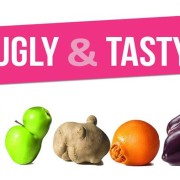Love Ugly Food
Haven’t you heard not to judge a book by its cover? Or perhaps, that beauty is only skin deep? Unfortunately, these lessons haven’t quite reached our grocery stores. Much of the produce harvested from farms across the U.S., is deemed too “ugly” for consumers to purchase. For example, according to an article published by NPR, an approximate 30-35% of potatoes grown in the U.S. have imperfections that keep them off grocery store shelves. That’s hundreds of millions of potatoes that are wasted! Can you imagine all the delicious mashed potatoes that could have been made? Believe it or not, ugly potatoes taste just like pretty potatoes once they’re mashed! But instead, they’re thrown away and sent to landfills where they benefit no one.
Food waste isn’t isolated to potatoes; Americans regularly waste edible, nutritious foods. We squeeze and sniff each piece of produce, with only the “cream of the crop” making it into our baskets. But what happens to that apple that has a spot on its flesh? Wouldn’t it have been perfectly suitable in the apple pie you were going to make with it? Instead, imperfect food is thrown away by grocery stores because it’s considered unsellable and inferior.
So what is the solution? In some places, a “love ugly food” movement has taken off. This movement has a basis in restaurants with creative and open minded chefs. Some of these chefs have taken ugly food, and made it trendy. Others, have found ways to hide less beautiful food, in soups and baked dishes where the appearance doesn’t matter in the first place.
You don’t have to pass the responsibility on to your restaurant chefs though. In your own culinary world, you can help to waste less. This starts when you’re choosing produce; keep in mind the journey it has taken. You might glimpse a stereotypically “beautiful” tomato, but this tomato was likely grown and picked thousands of miles from where you are purchasing it. This means, that this tomato was picked before it was ripe, shipped, and then artificially ripened with gas to make it appear pretty on the store shelf. Instead, try to choose local and heirloom options. The latter have more flavor, more nutrients, and more character.
When you’re cooking, you can also make an effort to use more of each food item you bring into your house. Strawberry tops can be tossed into smoothies, carrot tops can be added to salads, the nutritious skin can be left on your baked potato (sweet or not!), the stems of your mushrooms and broccoli are perfectly edible, and the seeds of all types of squash can be oven roasted for a snack. Using every edible part of produce can make a significant improvement in the amount of nutrients you gain, and a serious reduction in the amount of food wasted!
Want more ideas on how to waste less? Check out Food and Wine’s article: “7 Ways to Cook with Scraps and Help Stop Food Waste” –
http://www.foodandwine.com/blogs/2015/04/08/7-awesome-recipes-help-stop-food-waste?xid=blog_20150409_43486196&adbid=586272425031139329&adbpl=tw&adbpr=30278532


